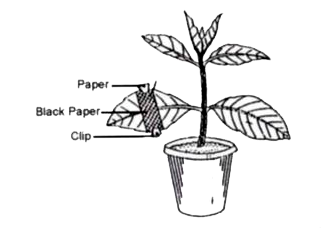Explain the mechanism of photosynthesis.
Step-by-Step Solution for the Mechanism of Photosynthesis
1. Definition of Photosynthesis:
Photosynthesis is the process by which plants, algae, and some bacteria convert light energy into chemical energy in the form of glucose. This process allows plants to produce their own food.
Hint: Remember that photosynthesis is essential for plants to create their own energy source.
2. Raw Materials Required:
The four main raw materials needed for photosynthesis are:
- Water (H₂O)
- Carbon Dioxide (CO₂)
- Chlorophyll (the green pigment in plants)
- Sunlight
Hint: Think of these materials as the ingredients needed for a recipe.
3. Photosynthesis Equation:
The overall chemical equation for photosynthesis can be represented as:
6CO2+6H2O+light energy→C6H12O6+6O2
This means six molecules of carbon dioxide and six molecules of water, in the presence of sunlight and chlorophyll, produce one molecule of glucose and six molecules of oxygen.
Hint: Memorizing the equation can help you understand the inputs and outputs of the process.
4. Absorption of Light Energy:
The first step in photosynthesis is the absorption of light energy by chlorophyll. This energy is crucial for driving the photosynthesis process.
Hint: Visualize chlorophyll as a solar panel that captures sunlight.
5. Conversion of Light Energy to Chemical Energy:
The absorbed light energy is converted into chemical energy. This energy is stored in the form of glucose, which is the food for the plant.
Hint: Think of this step as charging a battery; the energy is stored for later use.
6. Splitting of Water:
Water molecules are split during the process, which releases oxygen as a byproduct. This process is known as photolysis.
Hint: Remember that this is where the oxygen we breathe comes from!
7. Reduction of Carbon Dioxide:
Carbon dioxide undergoes a reduction process to form glucose. This means that CO₂ is transformed into a more complex molecule (glucose) using the energy captured from sunlight.
Hint: Consider this as building a structure from simple blocks (CO₂) to create something complex (glucose).
8. Storage of Food:
After glucose is produced, it can be converted into starch, which is stored in various parts of the plant for later use.
Hint: Think of starch as the pantry where the plant keeps its food reserves.
9. Overall Process:
All these events occur in a sequence, and they are essential for the survival of plants and, indirectly, for all living organisms on Earth, as they provide oxygen and food.
Hint: Remember that photosynthesis is a cycle that supports life on Earth.
Summary
Photosynthesis is a complex process that involves the absorption of light energy, conversion of that energy into chemical energy, splitting of water to release oxygen, and reduction of carbon dioxide to form glucose. The glucose produced is stored as starch, ensuring that plants have energy reserves.
Photosynthesis is the process by which plants, algae, and some bacteria convert light energy into chemical energy in the form of glucose. This process allows plants to produce their own food.
The four main raw materials needed for photosynthesis are:
- Water (H₂O)
- Carbon Dioxide (CO₂)
- Chlorophyll (the green pigment in plants)
- Sunlight
The overall chemical equation for photosynthesis can be represented as:
6CO2+6H2O+light energy→C6H12O6+6O2
This means six molecules of carbon dioxide and six molecules of water, in the presence of sunlight and chlorophyll, produce one molecule of glucose and six molecules of oxygen.
The first step in photosynthesis is the absorption of light energy by chlorophyll. This energy is crucial for driving the photosynthesis process.
The absorbed light energy is converted into chemical energy. This energy is stored in the form of glucose, which is the food for the plant.
Water molecules are split during the process, which releases oxygen as a byproduct. This process is known as photolysis.
Carbon dioxide undergoes a reduction process to form glucose. This means that CO₂ is transformed into a more complex molecule (glucose) using the energy captured from sunlight.
After glucose is produced, it can be converted into starch, which is stored in various parts of the plant for later use.
All these events occur in a sequence, and they are essential for the survival of plants and, indirectly, for all living organisms on Earth, as they provide oxygen and food.
Photosynthesis is a complex process that involves the absorption of light energy, conversion of that energy into chemical energy, splitting of water to release oxygen, and reduction of carbon dioxide to form glucose. The glucose produced is stored as starch, ensuring that plants have energy reserves.
Topper's Solved these Questions
- BOOK - NCERT EXEMPLAR ENGLISHCHAPTER - LIFE PROCESSESEXERCISE - Short Answer Type Questions36videos
LIFE PROCESSES
- BOOK - NCERT EXEMPLAR ENGLISHCHAPTER - HOW DO ORGANISMS REPRODUCEEXERCISE - Long Answer Type Questions10videos
HOW DO ORGANISMS REPRODUCE
- BOOK - NCERT EXEMPLAR ENGLISHCHAPTER - OUR ENVIRONMENTEXERCISE - LONG ANSWER TYPE QUESTIONS8videos
OUR ENVIRONMENT
Similar Questions
In photosynthesis
View SolutionExplain the mechanism of the photochemical reaction occurring between hydrogen and chlorine gas.
View SolutionExplain the mechanism of the photochemical reaction occurring between hydrogen and chlorine gas.
View SolutionExplain the mechanism of the photochemical reaction occurring between hydrogen and chlorine gas.
View SolutionPhotosynthesis is
View SolutionPhotosynthesis is
View SolutionThe diagram given below represents an experiment to prove the importance of a factor in photosynthesis. Answer the questions that follow

Explain the process of PhotosynthesisView SolutionWrite the mode of pollination in Vallisneria and water lily. Explain the mechanism of pollination in Vallisneria.
View SolutionDefine photosynthesis.
View SolutionPhotosynthesis is a
View Solution

